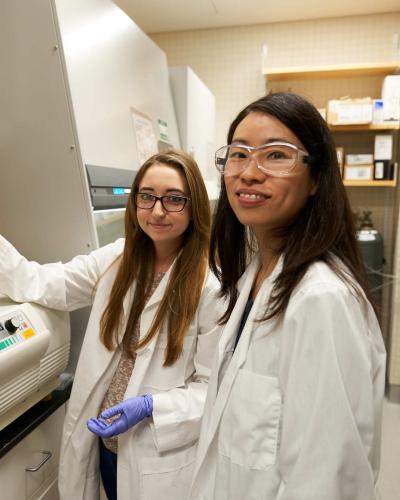Radiation therapy has been proven effective for the treatment of cancer, but its side effects can be severe depending on the patient and the location of the tumor.
Targeted alpha therapy (TAT), introduced within the last 15 years, involves injecting alpha-emitting radionuclides into the body. These metal ions are attached to tumor-seeking molecules by a process known as chelation. The molecules then deliver these radioactive ions to cancer cells, where they release high-energy alpha particles that kill the tumor cells. Due in part to the radioactive particles’ very short penetration range, there is minimal damage to surrounding tissue.
Four years ago, radium-223 dichloride was the first therapeutic alpha-emitting radionuclide to be approved by the Food and Drug Administration for clinical use in cancer patients. But radium-223 targets areas of bone metastasis and is not effectively attached to tumor targeting molecules, which would be needed to treat widespread metastatic cancers.
Another radionuclide, actinium-225 (Ac-225), has shown promise in treating soft-tissue metastases but with one drawback: The chemistry necessary to attach this metal ion to tumor-targeting vectors is less than ideal, as it requires labeling procedures that are incompatible with many targeting vectors such as antibodies.
A Cornell team led by Justin Wilson, assistant professor in the Department of Chemistry & Chemical Biology in the College of Arts and Sciences, and John Babich, professor of radiopharmaceutical sciences in radiology at Weill Cornell Medicine, has addressed that problem by developing a chelating agent that can be easily incorporated into a variety of targeting molecules, and which rapidly and stably attaches Ac-225 to targeting vectors at room temperature.
The group’s report, “An Eighteen-Membered Macrocyclic Ligand for Actinium-225 Targeted Alpha Therapy,” was published Oct. 16 in Angewandte Chemie, a publication of the German Chemical Society. Lead author is Nikki Thiele, postdoctoral researcher in the Department of Chemistry and Chemical Biology and a member of the Wilson Lab.
Also contributing as co-senior author was Valery Radchenko, research scientist at TRIUMF national particle and nuclear physics laboratory in Vancouver, British Columbia, which produced the radioactive Ac-225 used in the study.
Ac-225 is highly promising for use in TAT owing to its 10-day half-life, which is compatible with antibody-based targets, and its high-energy, short-distance alpha emissions that are extremely lethal to cancer cells while largely sparing surrounding cells. But a key challenge for implementation as a cancer therapy is the lack of a suitable bifunctional chelator that can rapidly bind and stabilize the ion.
Chelation of Ac-225 is currently done using the 12-membered ligand (attachment) known as DOTA. But DOTA’s physical and chemical limitations make it a poor candidate for use in TAT, so Wilson’s group focused its attention on a different ligand, the 18-membered H2macropa.
Macropa proved a highly effective chelator for Ac-225, forming a highly stable complex with the large ion quickly – in just five minutes – at room temperature.
“Think about what you need to do in a clinical or hospital setting,” Wilson said. “You need to have your radioisotope, and you need to mix it with your targeting vector containing a chelating agent. If you can do that in a very simple ‘shake-and-bake’ method – and I think we’ve demonstrated that you can – that would be ideal.
“You basically just add the isotope, mix it up in five minutes at room temperature, and it’s ready to go,” he said.
The group also reported development of an analogue to macropa, which they successfully conjugated to two different types of vectors – a breast cancer-targeting antibody and a prostate cancer-targeting small molecule. When the latter molecule was injected into a mouse model of prostate cancer, residual Ac-225 was not found in any organ except for the tumor over four days.
This work was supported by Cornell and by a Pilot Award from the Weill Cornell Medicine Clinical and Translational Science Center, funded by the National Institutes of Health. The work also made use of Cornell’s NMR (nuclear magnetic resonance) Facility, which is funded by the National Science Foundation.
Babich, Thiele and Wilson are co-inventors of H2macropa, the chelating agent, which has been licensed to Noria Therapeutics. Babich is the co-founder of Noria, a company focused on developing targeted radiotherapeutics and molecular imaging probes for cancer therapy and imaging.






